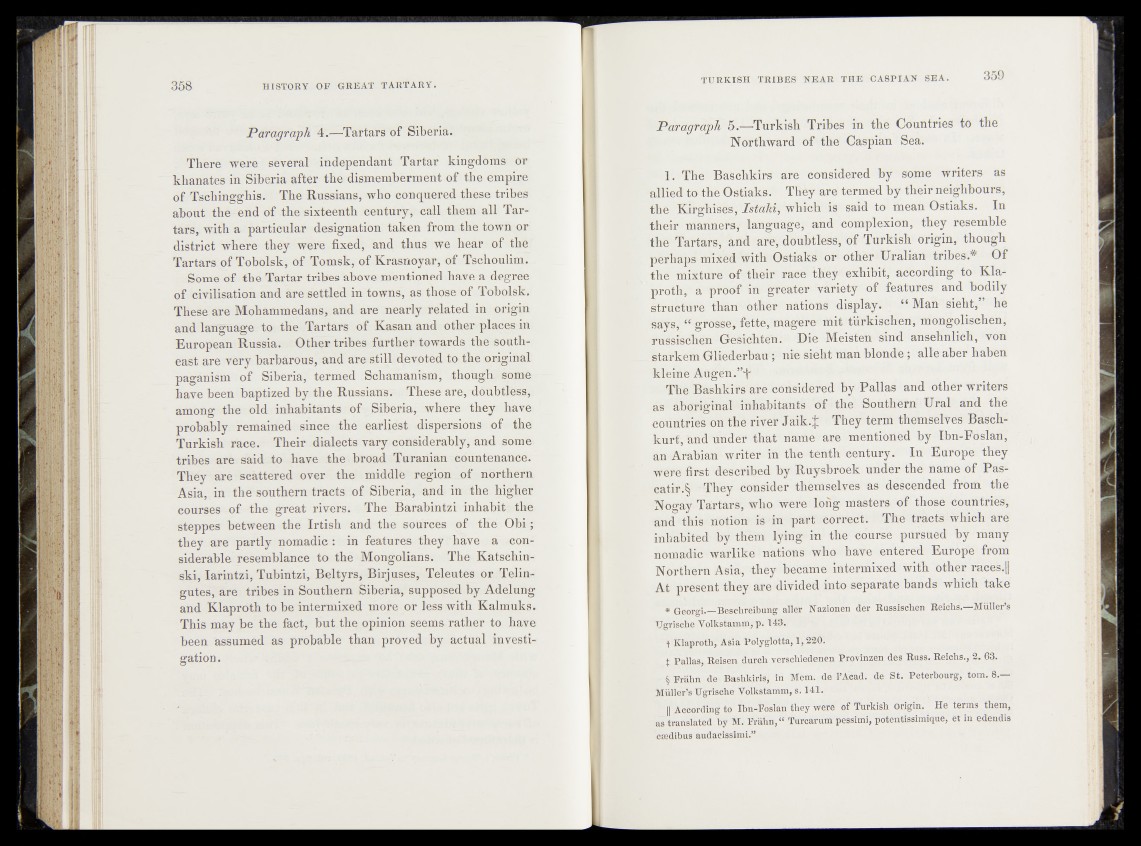
Paragraph 4.-—Tartars of Siberia.
There were several indépendant Tartar kingdoms or
khanates in Siberia after the dismemberment of the empire
of Tschingghis. The Russians, who conquered these tribes
about the- end of the sixteenth century, call them all Tartars,
with a particular designation taken from the town or
district where they were fixed, and thus we hear of the:'
Tartars of Tobolsk, of Tomsk, of Krasnoyar, of Tschoulim.
Some o f the Tartar tribes above mentioned have a degree
of civilisation and are settled in towns, as those of Tobolsk.
These are Mohammedans, and are nearly related in origin
and language to the Tartars of Kasan and other plaqescim
European Russia. Other tribes further towards ,tbté Southeast
are very barbarous, and are still devotedto IheiiWginal
paganism of Siberia, termed Schamanism, though, some-
have been baptized by the Russians. ,• ■ These are,-dxkifetjfess/-
among the old inhabitants of-Siberia, wherh they have
probably remained since the earliest dispersions ©fipthe
Turkish race. Their dialects vary considerably, and some>
tribes are said to have the broad Turanian .countenance;
They aré scattered over the middle region ...of ».nSrthern
Asia,; in the southem tracts of Siberia, and in the higher
courses of the great rivers. The Barabintzi inhabit! the
steppes between the Irtish and the sources of the- Obi ;
they are partly nomadic : in features they have a considerable
resemblance to the Mongolians. The Katschi#-:
ski, Iarintzi, Tubintzi, Beltyrs# Birjuses, Teleutes or Telin-
gutes, are tribes in Southern Siberia, supposed by Adelung
and Klaproth to be intermixed more or less with Kalmuks.
This may be the fact, but the opinion seems rather to have
been assumed as probable than proved by actual investigation.
TURKISH TRIBES NEAR THE CASPIAN SEA. 359
Paragraph 5‘.—Turkish Tribes in the Countries to the
Northward of the Caspian Sea.
1. The Baschkirs are considered by some writers as
allied tothe Ostiaks. They are termed by their neighbours,
the KirgMsSs, Istdkij which4 is said to mean Ostiaks. In
fyheir manners,- language, and complexion, they resemble
the Tartars, and are, doubtless,Af Turkish origin, though
p'erhaps mixed with Ostiaks or other Uralian tribes.* Of
thl^mxture of their race^ Ihey exhibit, according to Klaproth,
a proof in greater Variety of features and bodily
structure than other nations display. “ Man sieht,” he
says,*“ grosse, fette, magere’ mit türkischen, mongolischen,
russischen = G ich ten . Die Meisten’sind ansehnlich, von
.s-tafkem Gliederbau;^iile sieht man blonde; alle aber haben
M%Sie Augen.”1!*’*
The Bashkirs are considered by Pallas and other writers
ak’Aboriginal inhabitants 'of: the | Southern Ural and th#
countries on the river Jaik.J They term themselves Basch-
kurf, ’and under that m am e are mentioned by Ibn-Foslan,
an Arabian writer in» the»tenth century. In Europe they
were first described by Ruysbroek under ^the name of Pas-
catir.§ - They consider them selves^ ns descended sfrom the
Nogafi Tartars, who were'.long-masters of those countries,
and tfbis notion is-in part'Correct. The tracts which are
inhabited -by thei#dying in the bodice pursued by many
nomadic warlike matiofts who have-entered Europe from
Northern Asia, they became^intermixed with'other races.||
At present they are divided into separate bauds which take
Beschreibung aller ’ Nazionen der Russischen Reichs.—Müller’s
‘'^fgrische Volk stamm, p.' >-■
t Klaproth, Asia ^öiyglotta, 1,220.
X Pallas Reisen durch verschiedenen!,^Provinzen des Russ. Reichs., 2. 63. ;
- % Frähn de- Bashkir«# 'ln Men« >de*FAead. de Peterbourg, tom. 8 . ^
Müller’s Ugrische Volkstamm, s.
According to fbü-Foslan M e ^ lv |^ of TurkiSh origih. He terms them,
aTtrattBlated! hy Ä. Frähn,Furcarum pessimi, potentissimique, et in edendis
ctedibus audacisslmi.”